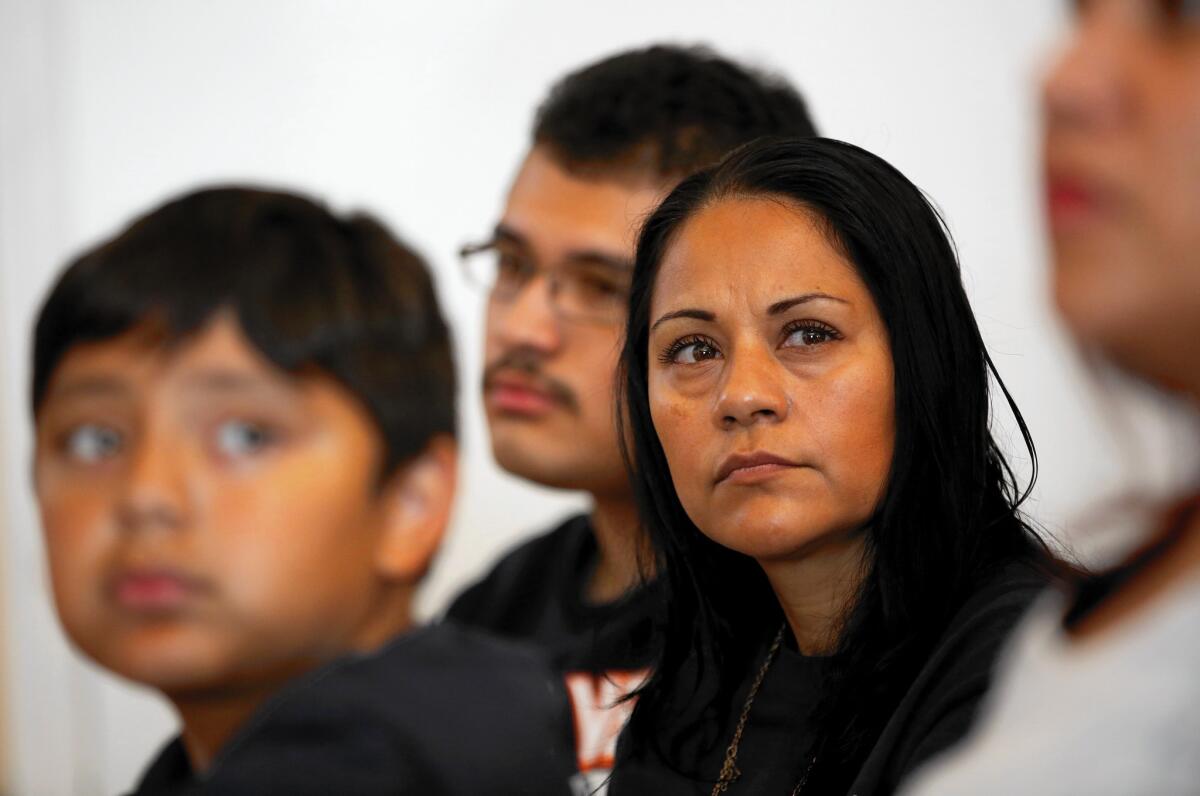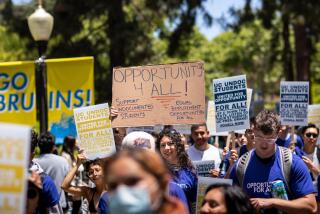For those in California illegally, health services vary greatly by county

Margarita Vasquez lacked health insurance and couldn’t afford an eye operation to ward off blindness.
But under a Los Angeles County program that extends healthcare services to poor residents who are in the country illegally, the 64-year-old underwent surgery earlier this year and can now see clearly.
“It saved me,” she said.
An hour’s drive to the east, in the flatlands of the Inland Empire, Sujey Becerra wasn’t as fortunate.
The 39-year-old didn’t have the means to pay for a surgery to remove ovarian cysts and put off the procedure for months, until she began hemorrhaging and was rushed to a hospital emergency room. Scarring from the last-minute operation left her hurting, and without access to follow-up treatment.
“I’m in pain constantly — all night, all day,” she said.
For uninsured California immigrants such as Vasquez and Becerra, which side of a county line they live on can significantly affect the care available when they’re sick.
Counties are required under a 1933 state law to “relieve and support all incompetent poor, indigent persons.” That requirement has been open to interpretation when it comes to healthcare for those in the country illegally. Among the 11 counties that provide low-cost medical care to such immigrants, some limit treatment to seriously ill patients or children.
The remaining 47 counties do not consider these immigrants to be covered by the state mandate.
County-to-county differences in such care have existed for decades. But President Obama’s overhaul of the healthcare system is focusing new attention on the disparities and complicating choices for local officials as they consider what, if any, healthcare they should provide to Californians who remain uninsured.
“Everything is getting shaken up,” said Catherine Teare, senior program officer for health reform at the California HealthCare Foundation, noting that the Affordable Care Act altered how the state’s healthcare system is funded and operates.
With health insurance coverage expanded to millions more Californians, people living here illegally — who are barred from signing up for Obamacare — now make up the single biggest group of uninsured state residents. A quarter of that population has private insurance coverage through their job or that of a family member, researchers say. But that leaves close to 1.5 million uninsured.
Now, advocates for the poor are urging state and county officials to wade back into discussions about politically sensitive and potentially costly options for improving healthcare for those living here illegally.
Last week, the state Senate passed a bill,with most Republicans opposed, that would provide healthcare to hundreds of thousands of children younger than 19 who are here illegally.
Some have sharply criticized efforts to expand such coverage. “They seem to stay up late in Sacramento thinking up new benefits and services to provide to illegal aliens, even as they’re cutting back services to everybody else,” said Ira Mehlman, a spokesman for the Federation for American Immigration Reform.
However, reductions made in county health program funding to help finance Obamacare have made it more difficult for some local officials to add — and in some cases maintain — medical care for the poor and residents living here illegally. The state withdrew some $900 million from local programs to help pay for expanded insurance coverage for those eligible to receive Medi-Cal, the government medical program for the poor.
Poor immigrants who aren’t eligible for free or subsidized insurance plans offered by the state can go to emergency rooms and community free clinics, but generally don’t have access to specialists or surgery. For just a portion of emergency room visits and pregnancy care involving those living here illegally, the state pays an estimated $1.4 billion annually.
Some experts argue that leaving large numbers of residents uninsured and relying on emergency rooms as a last-resort form of healthcare will undercut savings anticipated under Obamacare. UCLA health policy professor Steven Wallace noted the federal health system overhaul is based on an expectation that easy access to regular, preventive care will keep patients healthy and reduce overall medical costs.
According to projections from UC Berkeley and UCLA, people in the country illegally will continue to make up about half the roughly 3 million Californians lacking insurance four years from now.
“That’s the next big group to go after,” Wallace said.
Proponents of increased coverage point out that in recent years Californians have shown a willingness to extend privileges to those living here illegally, including driver’s licenses and lower-cost, in-state tuition at the state’s public colleges and universities.
One recent survey conducted for the Public Policy Institute of California found that 80% of Californians favored a path to citizenship for those living here illegally, including 66% of Republicans.
With more elected officials voicing support for expanded medical coverage for those residents, the big question has become: Whose financial responsibility is it?
State officials are considering picking up at least some of the cost.
Marcos Torres, 45, has lived in San Bernardino for a quarter of a century. Torres says he can’t afford health insurance for him or his wife on his construction worker’s salary. And the county doesn’t provide any free or low-cost healthcare for those in the U.S. illegally.
Torres — who has two daughters, one a student attending UC Irvine on a scholarship and the other in high school — said he couldn’t recall visiting a doctor. His children are U.S. citizens who qualify for various types of coverage. But when Torres or his wife get sick, he said, they take over-the-counter medicines and wait until they recover. “That’s what we do, we go and get the Tylenol,” he said.
He said neither he nor his wife have been seriously sick, but he worries about what will happen as they age.
San Bernardino County officials, citing increased costs, say they have no plans to expand coverage to residents such as Torres. But some other counties that haven’t offered such services in the past are rethinking the issue. One is Sacramento.
The county’s elected Board of Supervisors is considering providing primary and specialty care, on a first-come, first-served basis, to roughly 10,000 of the county’s 50,000 immigrants lacking proper legal status.
The one free clinic in the county that serves such patients often has a line around the block hours before it opens at 7 a.m.
Annie Fox, an advocate with the community group Sacramento ACT, recalled her effort to get help for a 14-year-old son of a farmworker who injured his tailbone in a trampoline accident. He developed a golf-ball-sized bump on his back that remains uncomfortable and sometimes becomes infected.
Despite repeated efforts to get him the care he needed, Fox said he still hasn’t qualified for services, five years later.
In other counties, officials are likely to be reluctant to increase services because of the recent state funding cuts for health services, said Gabrielle Lessard, a health policy attorney at the National Immigration Law Center. A total of $900 million was withdrawn from counties this fiscal year to help finance other parts of Obamacare.
Alex Briscoe, director of Alameda County’s Health Care Services Agency, said the cuts could end up reducing county services for the remaining uninsured — what he calls “one of the unintended consequences of the Affordable Care Act.” He said his county lost 80% of the $51 million a year the county previously spent on the program.
Becerra in San Bernardino County says she hasn’t been able to work and hopes the state or county will one day provide the health coverage she needs. She said she’s unsure what to do about her medical problems, but generally has been happy living in California the last six years. Her 10-year-old autistic son is getting a better education, she said, and she feels safer than if she stayed in Mexico.
“My plan is to live,” she said.
Follow @skarlamangla for more California health news
Soumya Karlamangla’s reporting on the remaining uninsured was undertaken as a California Health Journalism Fellow at USC’s Annenberg School of Journalism.
More to Read
Sign up for Essential California
The most important California stories and recommendations in your inbox every morning.
You may occasionally receive promotional content from the Los Angeles Times.











